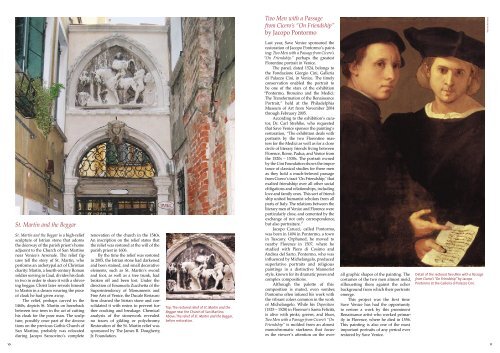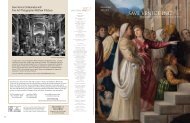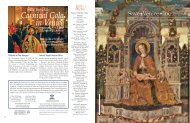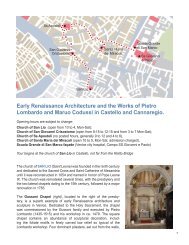Two Men with a Passagefrom Cicero’s “On Friendship”by Jacopo PontormoMarina NahabedSt. Martin and the BeggarSt. Martin and the Beggar is a high-reliefsculpture of Istrian stone that adornsthe doorway of the parish priest’s homeadjacent to the Church of San Martinonear <strong>Venice</strong>’s Arsenale. The relief figurestell the story of St. Martin, whoperforms an archetypal act of Christiancharity: Martin, a fourth-century Romansoldier serving in Gaul, divides his cloakin two in order to share it with a shiveringbeggar. Christ later reveals himselfto Martin in a dream wearing the pieceof cloak he had given away.The relief, perhaps carved in the1460s, depicts St. Martin on horsebackbetween two trees in the act of cuttinghis cloak for the poor man. The sculpture,possibly once part of the decorationson the previous Gothic Church ofSan Martino, probably was relocatedduring Jacopo Sansovino’s completerenovation of the church in the 1540s.An inscription on the relief states thatthe relief was restored at the will of theparish priest in 1606.By the time the relief was restoredin <strong>2005</strong>, the Istrian stone had darkenedand been stained, and small decorativeelements, such as St. Martin’s swordand foot, as well as a tree trunk, hadbroken off and been lost. Under thedirection of Emanuela Zucchetta of theSuperintendency of Monuments andFine Arts of <strong>Venice</strong>, the Ducale Restaurofirm cleaned the Istrian stone and consolidatedit with resins to prevent furthercracking and breakage. Chemicalanalysis of the stonework revealedno traces of gilding or polychromy.Restoration of the St. Martin relief wassponsored by The James R. Dougherty,Jr. Foundation.Top: The restored relief of St. Martin and theBeggar near the Church of San Martino.Above: The relief of St. Martin and the Beggar,before restoration.Last year, <strong>Save</strong> <strong>Venice</strong> sponsored therestoration of Jacopo Pontormo’s painting:Two Men with a Passage from Cicero’s“On Friendship,” perhaps the greatestFlorentine portrait in <strong>Venice</strong>.The panel, dated 1524, belongs tothe Fondazione Giorgio Cini, Galleriadi Palazzo Cini, in <strong>Venice</strong>. The timelyconservation enabled the portrait tobe one of the stars of the exhibition“Pontormo, Bronzino and the Medici:The Transformation of the RenaissancePortrait,” held at the PhiladelphiaMuseum of Art from November 2004through February <strong>2005</strong>.According to the exhibition’s curator,Dr. Carl Strehlke, who requestedthat <strong>Save</strong> <strong>Venice</strong> sponsor the painting’srestoration, “The exhibition deals withportraits by the two Florentine mastersfor the Medici as well as for a closecircle of literary friends living betweenFlorence, Rome, Padua, and <strong>Venice</strong> fromthe 1520s – 1530s. The portrait ownedby the Cini Foundation shows the importanceof classical studies for these menas they hold a much-beloved passagefrom Cicero’s tract ‘On Friendship,’ thatexalted friendship over all other socialobligations and relationships, includinglove and family ones. This sort of friendshipunited humanist scholars from allparts of Italy. The relations between theliterary men of <strong>Venice</strong> and Florence wereparticularly close, and cemented by theexchange of not only correspondence,but also portraiture.”Jacopo Carucci, called Pontormo,was born in 1494 in Pontormo, a townin Tuscany. Orphaned, he moved tonearby Florence in 1507, where hestudied with Piero di Cosimo andAndrea del Sarto. Pontormo, who wasinfluenced by Michelangelo, producedsuperlative portraits and religiouspaintings in a distinctive Manneriststyle, known for its dramatic poses andcomplex compositions.Although the palette of thiscomposition is muted, even somber,Pontormo often infused his work withthe vibrant colors common in the workof Michelangelo. While his Deposition(1525 – 1528) in Florence’s Santa Felicità,is alive with pinks, greens, and blues,Two Men with a Passage from Cicero’s “OnFriendship” is molded from an almostmonochromatic starkness that focusesthe viewer’s attention on the over-all graphic shapes of the painting. Thecostumes of the two men almost meld,silhouetting them against the ocherbackground from which their portraitsemerge.This project was the first time<strong>Save</strong> <strong>Venice</strong> has had the opportunityto restore a work by this prominentRenaissance artist who worked primarilyin Florence, where he died in 1556.This painting is also one of the mostimportant portraits of any period everrestored by <strong>Save</strong> <strong>Venice</strong>.Detail of the restored Two Men with a Passagefrom Cicero’s “On Friendship” by JacopoPontormo at the Galleria di Palazzo Cini.10 11
Boston EventsThe Boston Chapter continued a busyslate of events in 2004-05 under theable leadership of chairman Juan Prieto.Boston executive committee membersSusan Angelastro and Donald Freemanprovided invaluable creative and organizationalhelp for all of these events. TheAnnual Meeting was held on October19 at the Tavern Club. Prof. RafaelBras of the Massachusetts Institute ofTechnology discussed <strong>Venice</strong>’s acqua alta(high water), environmental complications,and the engineering solutionspresently under construction.Lecture SeriesThe spring lecture series, revived lastyear by Juan Prieto, continued to drawlarge and varied audiences. On March29, at the Chilton Club, Daniel Stepner(baroque violin) and Laura Jeppesen(viola da gamba) presented a lectureperformanceentitled Musical Lights ofEighteenth-Century Veneto. On April 25at the Ritz-Carlton Hotel, board memberFrederick Ilchman filled in at thelast minute when the lecturer was indisposed,delivering a talk entitled TheRestoration Process and Recent Successes inthe World’s most Fragile City. On May 25,the Chapter’s annual excursion to theCountry Club in Brookline, MA broughtthe season to a resounding conclusion.Patricia Fortini Brown, Chairman of theDepartment of Art and Archaeology atPrinceton University and a <strong>Save</strong> <strong>Venice</strong>board member, gave a brilliant lectureon Life in the Venetian Renaissance Palaceto a standing-room-only audience.Una Cena VenezianaThe tireless enthusiasm of BarbaraLloyd ensured a very successful blacktieevening, Una Cena Veneziana, thattook place at the Boston Athenaeumon November 14. Michael Romano ofNew York City’s Union Square Caféselected a Venetian menu paired withnorthern Italian wines and spoke ongrowing up with Italian cooking. Thefunds raised will help to restore AndreaVicentino’s painting Wedding at Cana inthe Church of San Trovaso. The manysatisfied guests look forward to Barbaramaking this an annual event.Top Left: Hal Caroll and Victoria Di Stefano. Top Right: Krishna Simonetti and Steven Scotford.Above: Alexandra Foster, Lacy Garcia, Tamar Salter, Victoria Reed, Frederick Ilchman, AllisonDrescher, Juan Prieto, Meredith Roy, Faye Higbie, and Hollis Colby.St. Mark’s Day GalaOn April 23, <strong>2005</strong> the Boston YoungFriends held their annual fundraisingparty and the first Saint Mark’s DayGala. Two hundred young Bostoniansin black-tie and masks, all supporters of<strong>Venice</strong>, attended the festivities.For the second year, the Bostongroup relied on the kind sponsorship ofLux, Bond & Green. The Hartford basedcompany graciously provided elegantgifts for all attendees. On November4, 2004, at their Back Bay location, Luxhosted a reception, “La Notte Italiana,”to introduce Mario Buccellati and hisfine jewelry collection.The proceeds of this year’s eventwill go to fund the restoration of theSaint Helen Altarpiece by Michele diMatteo (c.1430 – 7), currently locatedRoger Farringtonin Room I of the Accademia Galleries(see pages 8 – 9). The Boston YoungFriends have raised the necessary fundsto finance the cleaning, stabilization,and consolidation of this impressivepainting, including the paint surface,the wooden panel support, and theelaborate gilded frame.Next year’s Young Friends eventwill be co-chaired by Frederick Ilchmanand Meredith Roy. Allison Drescher willremain as the chairman of the YoungFriends in Boston. Under her tenureof seven years of chairing the Bostonevent, the Boston Young Friends raisedin excess of $350,000.Roger Farrington Roger FarringtonMatteo De Fina<strong>Venice</strong> EventsLecture SeriesThe <strong>Venice</strong> lecture series, “VeneziaRestaurata,” sponsored by FrancescaBortototto and the Hotel Bauer, is nowdedicated to the memory of board member,Prof. W.R. Rearick, who foundedthe series in 2000.At the first lecture of the spring<strong>2005</strong> series, held on January 31, RogerRearick’s friends and fellow art historiansFrederick Ilchman, Giovanna NepiScirè, Giandomenico Romanelli, AttiliaDorigato, Bernard Aikema, FrancesClarke, John Millerchip, and Nelli-Elena Vanzan Marchini affectionatelyremembered him with stories, tributes,anecdotes, and recollections of Rearick’slife dedicated to Venetian art.On March 10, Attilia Dorigato,Coordinator of Restoration in <strong>Venice</strong>Civic Museums, spoke on the <strong>Save</strong><strong>Venice</strong>-sponsored restorations of sixpaintings belonging to the CorrerMuseum. Prof. Rearick personallyselected these works of art for conservationfrom the Correr deposits, convincedthat their restoration would contributeto the scholarship of Venetian artby providing clues that would clarifyquestionable attributions.The third lecture, on March 24,focused on the work of Paolo Veronese.Stefania Mason, professor of Art Historyat the University of Udine presentedVeronese’s mythological paintings. Thelecture was planned to coincide with aVeronese exhibition at <strong>Venice</strong>’s CorrerMuseum.<strong>Save</strong> <strong>Venice</strong>’s restoration of thefaçade of the Scuola Grande di SanMarco was the subject of the May 12lecture, given by Grazia Fumo, DinoChinellato, and Silvia Magnani of theSuperintendency of Monuments andFine Arts of <strong>Venice</strong>.California EventsOn September 15, Hutton and RuthWilkinson hosted an evening atDawnridge, the historic and beautifulhouse of the late designer TonyDuquette, for the major supporters ofthe California Chapter of <strong>Save</strong> <strong>Venice</strong>.They discussed plans for the upcomingCarnival Gala, which will take place in<strong>Venice</strong> from February 18 to February 21,2006. During the evening, two pledgeswere made for major underwriting.Cat Pollen, a long-time supporter of<strong>Save</strong> <strong>Venice</strong> and a California Chapterstalwart, generously committed tounderwrite the Casanova evening atthe Ridotto, which will include dining,dancing, and traditional 18th-centurybetting games. Angie Barrett, visitingfrom Dallas, Texas, pledged to sponsorthe lectures and luncheon at the SanClemente Palace Hotel.A superb dinner was served andthere was great buzz and excitementat the prospect of experiencing carnivalin <strong>Venice</strong>. Many of those who havebeen to <strong>Venice</strong> scores of times havenot seen the famous spectacle. As ifthe carnival itself were not enough tolure one to magical <strong>Venice</strong>, the festivelunches, lectures, balls, and a specialtheatrical performance, written just forthis performance and underwritten byThe Walt Disney Company, should provideenticement to throw on a cape andmask and join in the fun. Many supportershave sent in their reservations,already making the event a successTerry Stanfill, Matthew White,Amanda Stonnington, and ShaneMcCoy, all co-chairs with HuttonWilkinson of February’s carnival, werein attendance as were many enthusiasticCalifornia Chapter supporters. Thegoal, as stated by the inimitable HuttonWilkinson, is to have every event fullyunderwritten so that all proceeds godirectly to <strong>Save</strong> <strong>Venice</strong>’s restorations.Many possibilities were discussed forreaching out to potential sponsors forunderwriting and to ask them to offerprizes for the best costumes. And nowthe work begins!Fulvio Zuliani and <strong>Save</strong> <strong>Venice</strong> Project Director,David Rosand, at the reception following theinauguration of the restored Scuola Grande diSan Marco façade. The façade was the topic ofthe May 12 lecture in the <strong>Venice</strong> series.New York EventsLecture SeriesThe New York Lecture Series was onceagain generously underwritten by a giftfrom the Hazen Polsky Foundation.On September 30, David B.Whitehouse, executive director of theCorning Museum of Glass, began thefall lecture series with Beyond <strong>Venice</strong>:Glass in Venetian Style, 1500-1750. Theslides shown allowed guests to seethe dramatic influence that Venetianglassware has had on numerous glassmakers.Eugene J. Johnson, the Classof 1955 Memorial Professor of Art atWilliams College, presented Inventing theOpera House on October 11. He providedinsight into the construction and creationof Venetian opera houses. On November11, Christopher Wood presented TheGlorious City – English Nineteenth-CenturyArtists in <strong>Venice</strong>. He showed the audiencemany remarkable depictions of <strong>Venice</strong>by lesser-known artists.Frederick Ilchman opened thespring lecture series on February 8,with How <strong>Save</strong> <strong>Venice</strong> <strong>Save</strong>s <strong>Venice</strong>: RecentRestorations in the World’s Most FragileCity. Members were able to see many ofthe restorations to which their donationshad been applied. On March 23, JohnCarswell discussed the Feast of the Gods:The Porcelain Trade between China, Istanbul,and <strong>Venice</strong>. Using Giovanni Bellini’sThe Feast of the Gods as evidence, heillustrated for us the strong connectionbetween the cities, which were linkedby the porcelain trade. Our <strong>2005</strong> seriesclosed on April 14 with Patricia FortiniBrown, new <strong>Save</strong> <strong>Venice</strong> board memberand Chairman of the Department of Artand Archaeology at Princeton. In her lecture,Seen but not Heard from: RenaissanceChildren and their Visual World, she usedvarious works of art to explore the livesof Renaissance children.Young Friends Dinner atthe Jason McCoy GalleryOn June 3, <strong>2005</strong> the Jason McCoyGallery and Caroline Bassett generouslygave an intimate dinner for membersof the Young Friends of <strong>Save</strong> <strong>Venice</strong>standing committee. Guests viewed thegallery’s collection, enjoyed an Italianmenu, and heard Stephen Cadwalader,Jackson Pollock’s nephew, speak aboutthe artist’s connection to <strong>Venice</strong>.12 13





